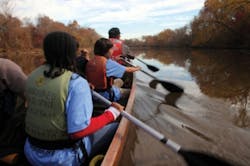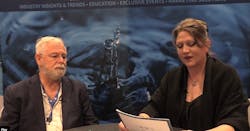Learning to paddle a voyageur canoe on the Anacostia River
|
The proud history of the Anacostia River and its tale of woe are offered as a metaphor for the similar practice of waterway abuse globally. "Sometimes called the forgotten river, the Anacostia flows from the Maryland suburbs of Washington to its mouth at the Potomac with a
watershed that is home to more than 2.4 million residents, including the most economically distressed in Washington," said Wennersten. The theme of the exhibition's opening section, "It's Our River," threads through the next five sections encouraging viewers to recognize their collective responsibility for the condition and future of the river. From the period of Native American habitation forward, the Anacostia's historical role as a transportation route, source of sustenance, facilitator of trade, commerce and defense (pre-locomotion and automobile) and haven for
recreational, artistic, cultural and spiritual respite is explained.
The challenges and visions posed by the impact of human settlement and industry on the Anacostia, such as the Navy Yard and the sports-stadium development, sewage/waste management, environmental justice issues and restoration of the environment, form the lens through which the approaches taken by other urban river communities are seen in the final section. Throughout the exhibition, viewers are challenged to consider their individual impact on the Anacostia river and specific ways citizens can do their part to clean the water.
"Experiences and points of view from men, women and children personally involved with their rivers distinguish this exhibition from others," said Lowe. "It is not just about science, biology, politics and industry, it is also about fishing, swimming, boating, drinking and enjoying the bounties clean waterways provide and our individual responsibility for keeping them healthy and safe."
"Reclaiming the Edge" features 75 objects, 16 works of art and 170 images. Highlights include:
- Five paintings by premier Chinese artist Zhang Jian-Jun selected from his 36-panel work on rivers
- A wooden "Gatita" (female kitten) painting by Chicano artist/environmentalist Leo Limon reminiscent of the cat faces he spray paints on the storm-drain covers along the L.A. River
- A stylized photo essay of the Anacostia River by local artist Bruce McNeil
- "Talking Trash," a mobile of a school of "fish" crafted from recycled bottles by interns working with the Smithsonian's Office of Exhibits Central
- "River Stories," eight digital stories in which local residents discuss their call to activism around river conservation
- "River of Memories," a video of older residents recalling memories of youthful interaction with the Anacostia River
The exhibition is funded in part by the Smithsonian Institution Women's Committee, the D.C. Commission on the Arts & Humanities, the headquarters and Region 3 offices of the U.S. Environmental Protection Agency and the Cornell Douglas Foundation.
About the Smithsonian's Anacostia Community Museum
Established in 1967, the Smithsonian's Anacostia Community Museum focuses on examining the impact of contemporary social issues on urban communities. For more information, call (202) 633-4820; for tours, call (202) 633-4844. Website: anacostia.si.edu.
###



